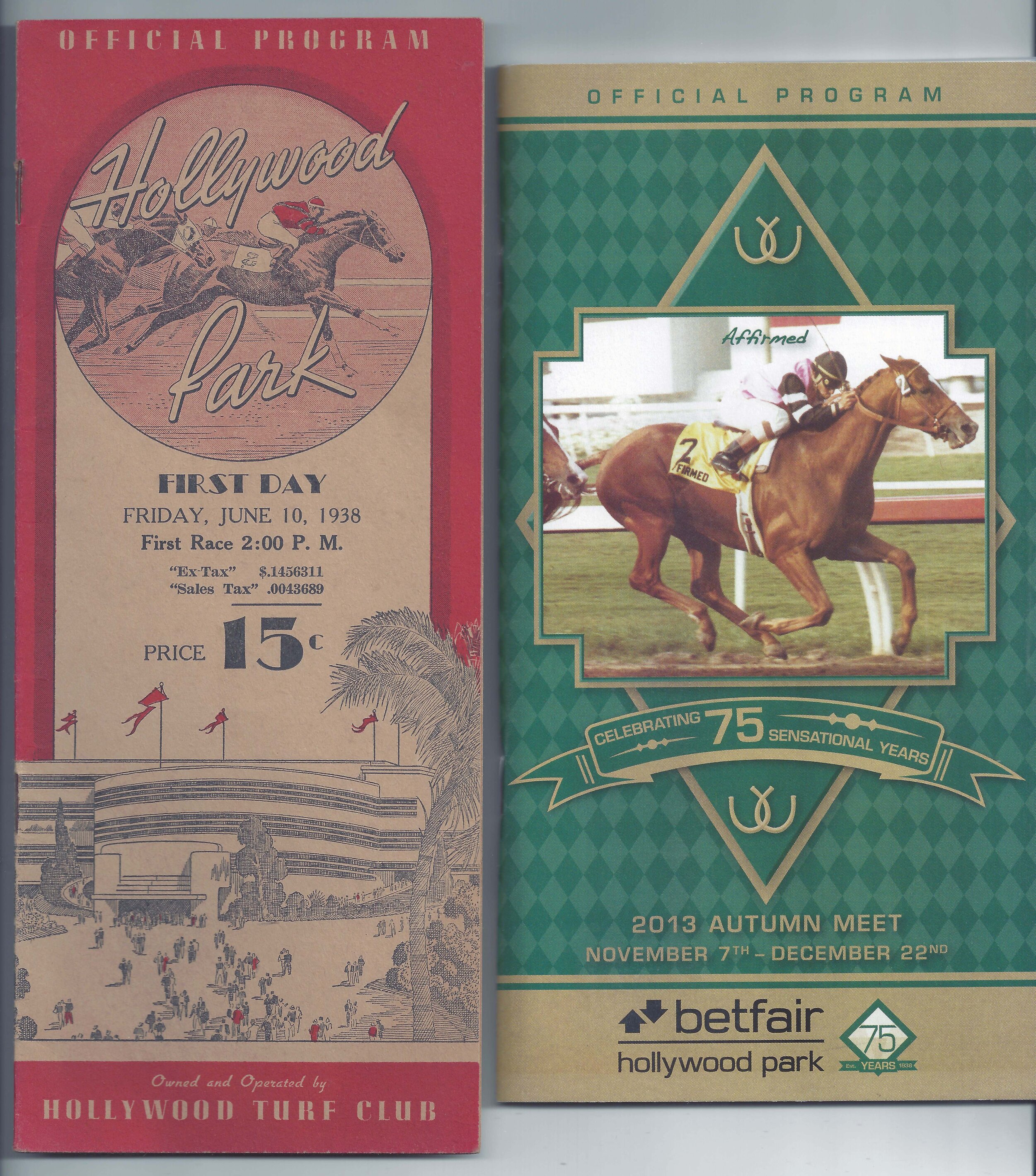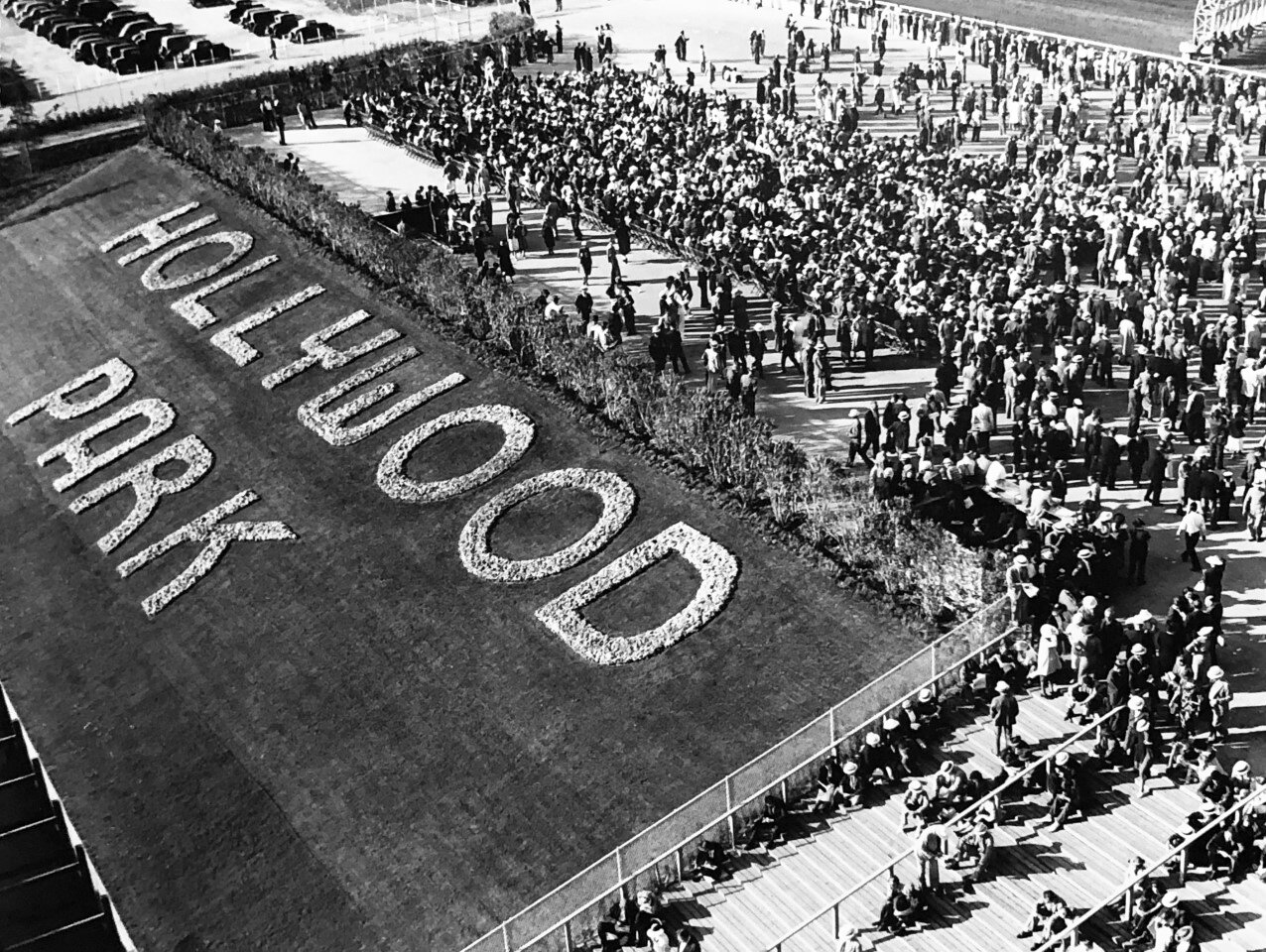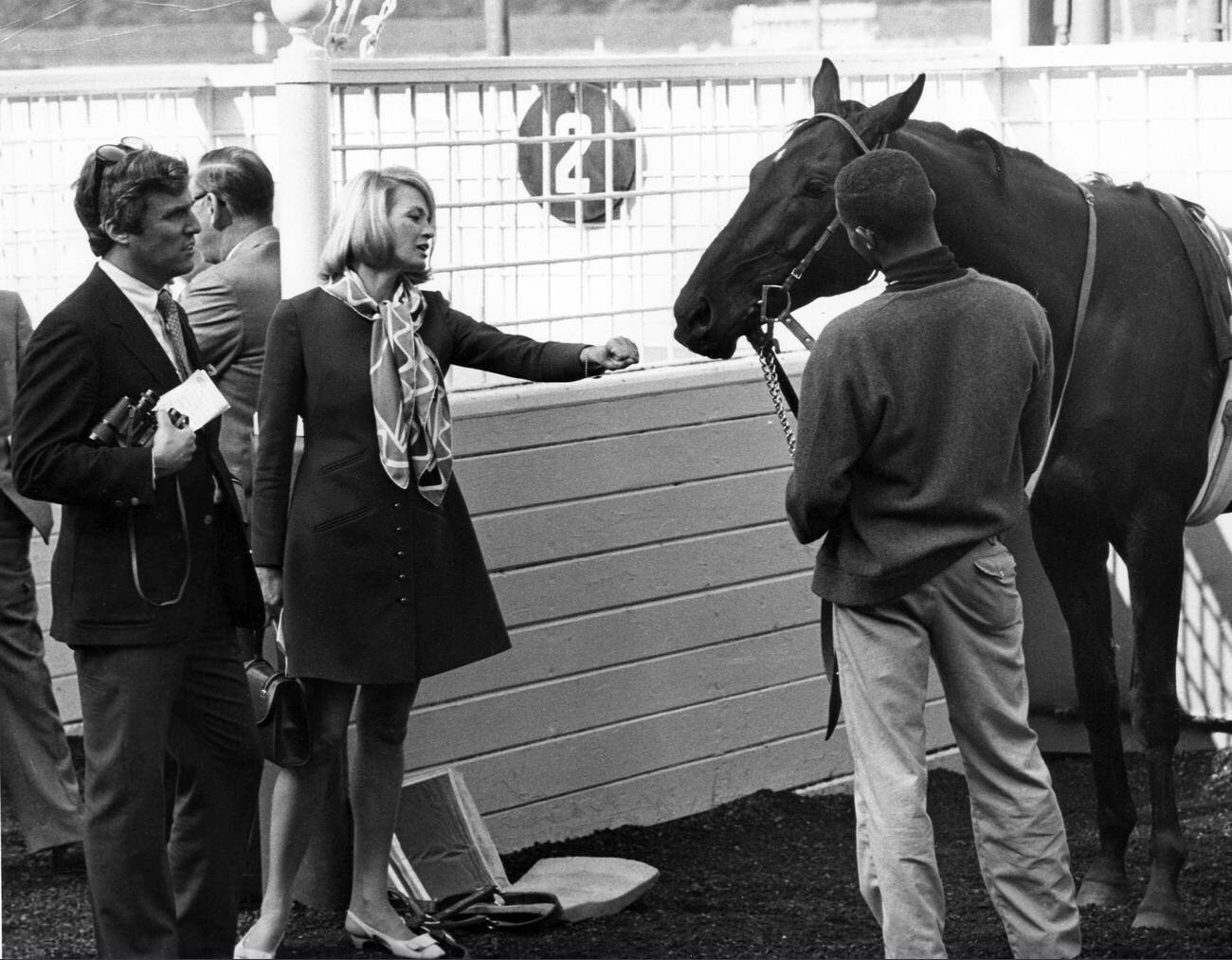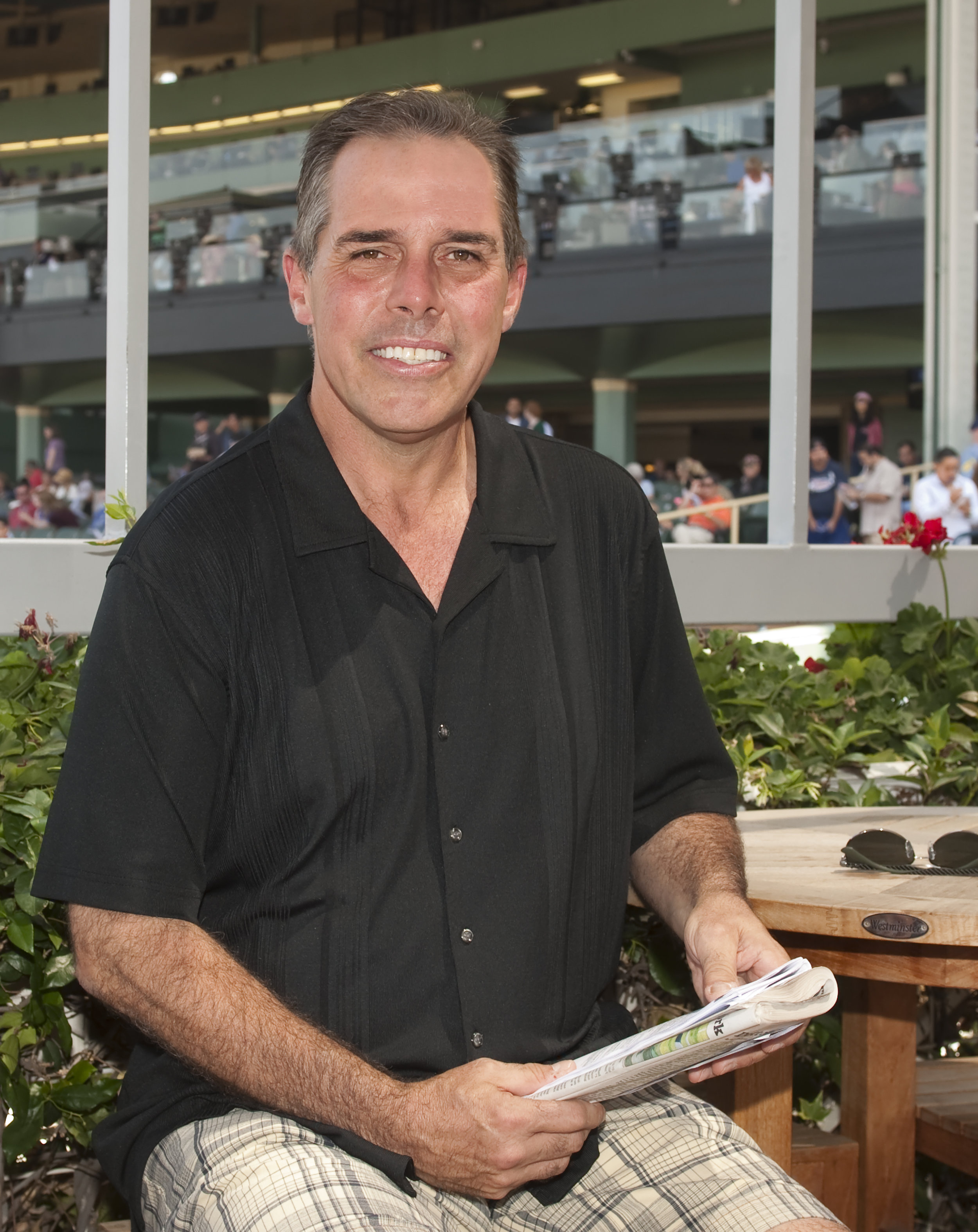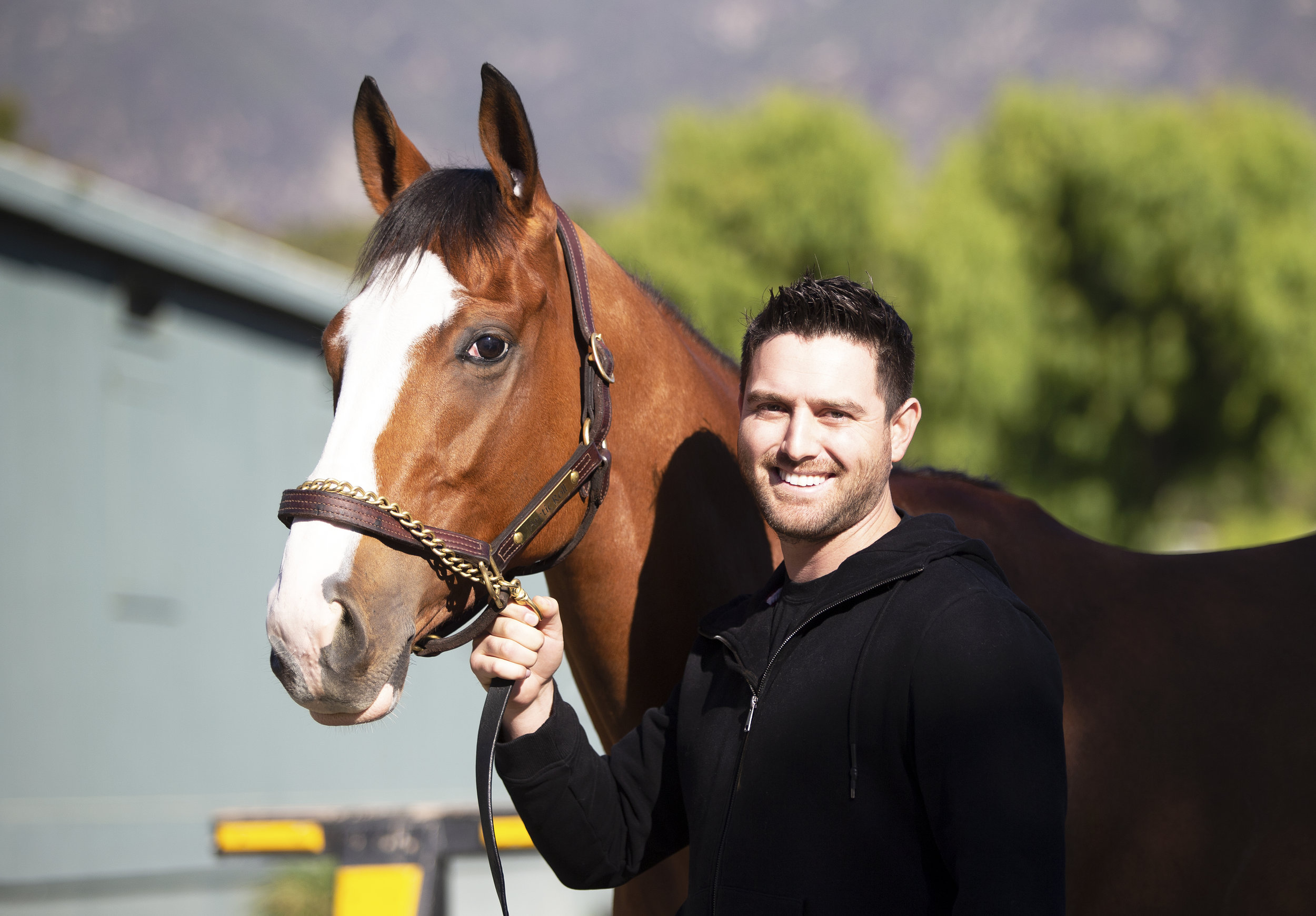Remembering Hollywood Park - Edward “Kip” Hannan and the Hollywood Park archive
/By Ed Golden
In an age of “Races Without Faces,” Edward Kip Hannan is a renaissance man.
Kip Hannan outside of UCLA’s Royce Hall
Not to be confused with an anarchist bent on destroying history’s truths, Hannan is an archivist, with an ethos dedicated to preserving timeless treasures and ensconcing them in pantheons for future generations.
With the artistic and obdurate passion of a Michelangelo, when Hollywood Park closed forever on Dec. 22, 2013, like a man possessed with an oblation, Hannan knew there was “gold in them thar hills” and dug in like he was assaulting the Sistine Chapel.
Far from a fool and capitalizing on today’s applied sciences, Hannan has successfully transitioned through more than four decades, surviving—yea, overcoming—a concern once epitomized by Albert Einstein who said: “I fear the day that technology will surpass our human interaction. The world will have a generation of idiots.”
Hannan made it his mission to rescue archives from the Inglewood, Calif. track that opened 75 years earlier on June 10, 1938. The Hollywood Turf Club was formed under the chairmanship of Jack L. Warner of the Warner Brothers film corporation.
Hollywood Park Opening Day and Closing Day programs.
Among the 600 original shareholders were many stars, directors and producers of yesteryear from movieland’s mainstream, including Al Jolson, Raoul Walsh, Joan Blondell, Ronald Colman, Walt Disney, Bing Crosby, Sam Goldwyn, Darryl Zanuck, George Jessel, Ralph Bellamy, Hal Wallis, Wallace Beery, Irene Dunne and Mervyn LeRoy.
They pale, however, compared to the equine stalwarts that raced at Hollywood Park, which include 22 that were Horse of the Year: Seabiscuit (1938), Challedon (1940), Busher (1945), Citation (1951), Swaps (1956), Round Table (1957), Fort Marcy (1970), Ack Ack (1971), Seattle Slew (1977), Affirmed (1979), Spectacular Bid (1980), John Henry (1981 and 1984), Ferdinand (1987), Sunday Silence (1989), Criminal Type (1990), A.P. Indy (1992), Cigar (1995), Skip Away (1998), Tiznow (2000), Point Given (2001), Ghostzapper (2004) and Zenyatta (2010).
Hannan obviously had his hands full, but thrust ahead undeterred as he soldiered on to digitize Hollywood Park’s entire film/video history of nearly 4,000 stakes races for eventual public access.
It seemed a mission mandated by a higher power.
Hannan, who turns 57 on Jan. 29, was born in Phoenix, Ariz., where his mother and father had come from Brooklyn. Moving to California when he was just two, they lived on the Arcadia/Monrovia border within a couple miles of storied Santa Anita, and left in 1972 for nearby Temple City where Kip has lived ever since.
In 1979, at the tender age of 15, he began working as a marketing aide at Santa Anita under the aegis of worldly racing guru Alan Balch and his fastidious publicity sidekick, Jane Goldstein.
Hollywood Park, 1939.
He was the last employee at Hollywood Park in order to organize archives for digitization and eventual transfer to the UCLA Library, where he began working in late 2014 as videographer and editor. He is still employed there, maintaining the integrity of Hollywood Park film, video, photo and book archives.
Hannan sums up his career in one word: “Fascinating.”
“I had already started collecting music at age 11, in 1975,” Hannan said, “and probably because of this, I associate many life events with the music of the time. I’m sure many people can relate.
“It was at Santa Anita where and when I first met Lou Villasenor, who was already working there and would go on to become a staple of its TV broadcast team—a job he held for nearly 35 years before his death in 2018.
“Lou became one of my best friends and eventually was the one who brought me to Hollywood Park where I was hired to work in its television department in 1986.”
As marketing aides, their tasks were menial and labor intensive, such as removing duplicates from mailing lists, organizing contest entry cards filled out by fans, and other simple office-related duties. After a few years, Hannan was promoted to supervisor.
At Santa Anita in 1982, Hannan met another new hire who became an instant best friend: Kurt Hoover, current TVG anchor whose relaxed and ingratiating on-camera presence is the stuff of network standards. He also is a devoted and skilled handicapper and a successful horse owner.
“We hit it off immediately,” Hannan says.
A couple years later, Hannan left Santa Anita briefly to study television production at Pasadena City College, while also finding time to work at Moby Disc Records in town.
Burt Bacharach and wife Angie Dickinson admire their race horse Apex II in his Hollywood Park stall, 1969.
“I had always been a movie buff, with the original 1933 ‘King Kong’ my inspiration, along with ‘One Million Years B.C., and not just because of Fay Wray and Raquel Welch—although I had crushes on both. It was the dinosaurs and the stop-motion filmmaking and special effects.
“I wanted to get into film somehow but couldn’t afford USC, so the gateway was video/television production, first in high school and then at Pasadena City College.
“It was around this time, summer of 1985, that Santa Anita contacted me out of the blue,” he said. “Knowing I had radio operation training in college, they told me of a radio station in the planning stages that would be an on-site source for racing fans and handicappers broadcasting information throughout the day.
“Nearly doubling my hourly wage from the record store, I jumped at the chance. It was designed and organized by the same company that created the low-power AM radio station that can be picked up near the LAX Airport for flight information; and soon, KWIN Radio AM was created.
“I was the operator/engineer with countless marketing people and handicappers available for on-air hosts and guests. It was at this time I met Mike Willman, the ‘roving reporter’ and program manager of sorts, who gathered interviews on his cassette recorder for us to air.
“On April 23, 1986, Villasenor took me to Hollywood Park where he was program director and graphics operator in its TV department.
“I was fortunate to be there and was in the right place at the right time. They were short of cameramen that day, and word came from Hollywood Park President Marje Everett that many of her personal friends would be attending, including popular celebrities of music, film, television and politics.
“The TV department was to capture ‘Opening Day Greetings’ from them on their arrival. The TV director asked if I could handle the professional portable camera, portable tape deck and tripod. I said yes, gathered up everything, and headed to the Gold Cup Room, avoiding crowded elevators with all that gear.
“It was then I realized my career was moving up, for at that moment, not three steps behind me on the escalator were Elizabeth Taylor and Michael Jackson. As we continued to climb, all I could think of was getting to a phone to tell my folks how my first day went, before it had even started!
Michael Jackson and Elizabeth Taylor, 1986.
“There is one particular snapshot taken in the Gold Cup Room that I cherish. I’m not in the photo but was about six feet ahead of them, walking with my gear like I was on top of the world at age 22.
“I did get Michael Jackson’s autograph later, as miraculously he only had one bodyguard with him that day. At the time, there was not a bigger pop music star on the planet, and it was surreal to see him right before me.
“Even though they both declined to appear on camera for a greeting, it was Elizabeth Taylor who got to me. As I set up my camera gear not 25 feet from where she was sitting (and momentarily alone), she glanced up from the table and looked directly at me with this big smile.
“I literally melted! As I continued to fumble getting the camera onto the tripod, I kept thinking, ‘Dear God, those eyes!’ and I was ready to sign on for husband number seven, as suddenly it had all made sense to me. …
CLICK HERE to return to issue contents
ISSUE 58 (PRINT)
$6.95
ISSUE 58 (DIGITAL)
$3.99
WHY NOT SUBSCRIBE?

![KIp HannanBy Ed GoldenIn an age of “Races Without Faces,” Edward Kip Hannan is a renaissance man.Not to be confused with an anarchist bent on destroying history’s truths, Hannan is an archivist, with an ethos dedicated to preserving timeless treasures and ensconcing them in pantheons for future generations.With the artistic and obdurate passion of a Michelangelo, when Hollywood Park closed forever on Dec. 22, 2013, like a man possessed with an oblation, Hannan knew there was “gold in them thar hills” and dug in like he was assaulting the Sistine Chapel.Far from a fool and capitalizing on today’s applied sciences, Hannan has successfully transitioned through more than four decades, surviving—yea, overcoming—a concern once epitomized by Albert Einstein who said: “I fear the day that technology will surpass our human interaction. The world will have a generation of idiots.”Hannan made it his mission to rescue archives from the Inglewood, Calif. track that opened 75 years earlier on June 10, 1938. The Hollywood Turf Club was formed under the chairmanship of Jack L. Warner of the Warner Brothers film corporation.Among the 600 original shareholders were many stars, directors and producers of yesteryear from movieland’s mainstream, including Al Jolson, Raoul Walsh, Joan Blondell, Ronald Colman, Walt Disney, Bing Crosby, Sam Goldwyn, Darryl Zanuck, George Jessel, Ralph Bellamy, Hal Wallis, Wallace Beery, Irene Dunne and Mervyn LeRoy.They pale, however, compared to the equine stalwarts that raced at Hollywood Park, which include 22 that were Horse of the Year: Seabiscuit (1938), Challedon (1940), Busher (1945), Citation (1951), Swaps (1956), Round Table (1957), Fort Marcy (1970), Ack Ack (1971), Seattle Slew (1977), Affirmed (1979), Spectacular Bid (1980), John Henry (1981 and 1984), Ferdinand (1987), Sunday Silence (1989), Criminal Type (1990), A.P. Indy (1992), Cigar (1995), Skip Away (1998), Tiznow (2000), Point Given (2001), Ghostzapper (2004) and Zenyatta (2010).Hannan obviously had his hands full, but thrust ahead undeterred as he soldiered on to digitize Hollywood Park’s entire film/video history of nearly 4,000 stakes races for eventual public access.It seemed a mission mandated by a higher power.Hannan, who turns 57 on Jan. 29, was born in Phoenix, Ariz., where his mother and father had come from Brooklyn. Moving to California when he was just two, they lived on the Arcadia/Monrovia border within a couple miles of storied Santa Anita, and left in 1972 for nearby Temple City where Kip has lived ever since.In 1979, at the tender age of 15, he began working as a marketing aide at Santa Anita under the aegis of worldly racing guru Alan Balch and his fastidious publicity sidekick, Jane Goldstein.He was the last employee at Hollywood Park in order to organize archives for digitization and eventual transfer to the UCLA Library, where he began working in late 2014 as videographer and editor. He is still employed there, maintaining the integrity of Hollywood Park film, video, photo and book archives.Hannan sums up his career in one word: “Fascinating.”“I had already started collecting music at age 11, in 1975,” Hannan said, “and probably because of this, I associate many life events with the music of the time. I’m sure many people can relate.“It was at Santa Anita where and when I first met Lou Villasenor, who was already working there and would go on to become a staple of its TV broadcast team—a job he held for nearly 35 years before his death in 2018.“Lou became one of my best friends and eventually was the one who brought me to Hollywood Park where I was hired to work in its television department in 1986.”As marketing aides, their tasks were menial and labor intensive, such as removing duplicates from mailing lists, organizing contest entry cards filled out by fans, and other simple office-related duties. After a few years, Hannan was promoted to supervisor.At Santa Anita in 1982, Hannan met another new hire who became an instant best friend: Kurt Hoover, current TVG anchor whose relaxed and ingratiating on-camera presence is the stuff of network standards. He also is a devoted and skilled handicapper and a successful horse owner.“We hit it off immediately,” Hannan says.A couple years later, Hannan left Santa Anita briefly to study television production at Pasadena City College, while also finding time to work at Moby Disc Records in town.“I had always been a movie buff, with the original 1933 ‘King Kong’ my inspiration, along with ‘One Million Years B.C., and not just because of Fay Wray and Raquel Welch—although I had crushes on both. It was the dinosaurs and the stop-motion filmmaking and special effects.“I wanted to get into film somehow but couldn’t afford USC, so the gateway was video/television production, first in high school and then at Pasadena City College.“It was around this time, summer of 1985, that Santa Anita contacted me out of the blue,” he said. “Knowing I had radio operation training in college, they told me of a radio station in the planning stages that would be an on-site source for racing fans and handicappers broadcasting information throughout the day.“Nearly doubling my hourly wage from the record store, I jumped at the chance. It was designed and organized by the same company that created the low-power AM radio station that can be picked up near the LAX Airport for flight information; and soon, KWIN Radio AM was created.“I was the operator/engineer with countless marketing people and handicappers available for on-air hosts and guests. It was at this time I met Mike Willman, the ‘roving reporter’ and program manager of sorts, who gathered interviews on his cassette recorder for us to air.“On April 23, 1986, Villasenor took me to Hollywood Park where he was program director and graphics operator in its TV department.“I was fortunate to be there and was in the right place at the right time. They were short of cameramen that day, and word came from Hollywood Park President Marje Everett that many of her personal friends would be attending, including popular celebrities of music, film, television and politics.“The TV department was to capture ‘Opening Day Greetings’ from them on their arrival. The TV director asked if I could handle the professional portable camera, portable tape deck and tripod. I said yes, gathered up everything, and headed to the Gold Cup Room, avoiding crowded elevators with all that gear.“It was then I realized my career was moving up, for at that moment, not three steps behind me on the escalator were Elizabeth Taylor and Michael Jackson. As we continued to climb, all I could think of was getting to a phone to tell my folks how my first day went, before it had even started!“There is one particular snapshot taken in the Gold Cup Room that I cherish. I’m not in the photo but was about six feet ahead of them, walking with my gear like I was on top of the world at age 22.“I did get Michael Jackson’s autograph later, as miraculously he only had one bodyguard with him that day. At the time, there was not a bigger pop music star on the planet, and it was surreal to see him right before me.“Even though they both declined to appear on camera for a greeting, it was Elizabeth Taylor who got to me. As I set up my camera gear not 25 feet from where she was sitting (and momentarily alone), she glanced up from the table and looked directly at me with this big smile.“I literally melted! As I continued to fumble getting the camera onto the tripod, I kept thinking, ‘Dear God, those eyes!’ and I was ready to sign on for husband number seven, as suddenly it had all made sense to me.“That was my first day as a TV professional that I’ll never forget.”Hannan also has noteworthy literary credits.“I was fortunate to be mentioned in the ‘thank you’ section of Laura Hillenbrand’s best-selling book, Seabiscuit, for simply providing her with basic Seabiscuit footage from Hollywood Park,” he said. “I sure wish I could have sent her all the eventual work I did years later, after I had restored all of Seabiscuit’s existing race films, including some four-minute vignettes on the 1938 Gold Cup, the famous match race with War Admiral and the 1940 Santa Anita Handicap, before her book was published.“Through a connection via Charlotte Farmer—a fan who had rescued the great horse Noor’s remains from land repurposing and moved them across the country to be reinterred at Old Friends in Kentucky—I contributed photos to Milton C. Toby’s book, Noor-A Champion Thoroughbred’s Journey from California to Kentucky.“These included the cover photo of Noor working out with Johnny Longden up, which came from a negative that had probably been unprocessed and unseen for 62 years!“A few years ago, I was asked to contribute to a book by photographer Michele Asselin, who had been commissioned to photograph and document the closing of Hollywood Park and its people during late 2013 and early 2014. It resulted in a coffee table photobook entitled Clubhouse Turn—The Twilight of Hollywood Park Race Track, which was published in March 2020.“With Roberta Weiser, we wrote a detailed Hollywood Park ‘timeline’ for the end of the book, to provide a sense of the track’s history, which was only being represented in the book by photos of its final months.“Without Roberta, the rescue, work and maintenance of the entire Hollywood Park archive would not have happened, and more importantly would not exist to this day.”Displaying his passion and knowledge of music globally from note to note, Hannan also edited a full-length DVD version of Laffit Pincay Jr.’s retirement ceremony at Hollywood Park in July 2003.“I added music from the Mascagni opera, Cavalleria Rusticana, during Laffit’s farewell speech,” Hannan said. “If you think of the music soundtracks to either the opening scene of Raging Bull (with the boxer in the ring by himself, feinting blows in slow motion) or the final scene on the steps in Godfather III, it might come to you.“If you don’t get a lump in your throat and your eyes don’t water when Laffit says, ‘I still have that fire inside me that I cannot put out . . .’ before he continues with his tearful and thoughtful farewell moment, hugging his very young son, his grown children and his mother, then we might need to check your pulse.”Another of Hannan’s highlights was the creation of a “quadruple whammy Living Legends” music video in 2005, honoring four recently retired legendary jockeys in the Hollywood Winners’ Circle: Pincay, Chris McCarron, Eddie Delahoussaye and Julie Krone. The piece was done with no narration, accompanied only by visuals and Electric Light Orchestra’s powerful instrumental, “Fire on High.”“As a music collector, researcher, cataloger, historian and fan, it’s not much of a stretch to see how I was able to latch on to the Hollywood Park archive and become its archivist. I treated it the same as my music collection, gathered it and organized it . . . I knew I had an audience that wanted history to remain alive, so I kept it going the next five or six years.“I restored clips of Seabiscuit winning the first Gold Cup in 1938 . . . found a color film reel with footage of Citation from 1951—probably not seen by anyone in 60 years—and had that professionally restored along with the earliest color film found of Hollywood Park from 1945. The cool stuff just kept turning up . . . Native Diver’s 1967 farewell parade after his third consecutive Gold Cup victory, Cougar II’s 1971 win over Fort Marcy in the Hollywood Turf Invitational, and the 1978 Swaps Stakes with J.O. Tobin beating Triple Crown winner Seattle Slew in front of 68,000 fans.”Hannan’s favorite race is Lava Man winning a third consecutive Gold Cup in 2007, tying Native Diver’s mark. “I stood up and screamed all the way down the stretch at the TV screen in my little editing room,” he said. “What a race and what a finish! Thank you, Lava Man and Corey Nakatani.”But had the fates allowed, his choice would have been the 2010 Breeders’ Cup Classic in which Zenyatta, the remarkable stretch-running mare, suffered her only defeat after 19 straight dramatic come-from-behind victories, losing by a head to Blame ridden by the late Garrett Gomez.“’Zenyatta: Queen of Racing,’ was a career highlight for me and the best I’ve ever done,” said Hannan, who enlisted Jay Hovdey to help script it. “Such a beautiful horse and fan favorite. Her wonderful story was easy to tell, but once again I had to tell it right for her legion of fans.”The Zenyatta story was buoyed, thanks to music by The Police and Sting, and by Hannan’s brother Chris, who composed all the original music.Added Hannan: “I still feel Zenyatta gave her greatest performance in defeat, making up 18 lengths at one point against the best boys in the world at her age [six], at night with lights on [a first for her] and on an unfamiliar [Churchill Downs] surface.“That stretch run was another screamer for me, but to come up short by so little was a heartbreaker . . . If she gets up and beats Blame, it’s the greatest race of all time. That’s my two cents; sorry, Lava Man.”Hannan’s favorite tale is about horse owner and music legend Burt Bacharach who was at Hollywood in 1996 but on this particular day had a horse running at Keeneland and wanted to see the race.Hannan picks it up from there. “Our TV department scrambled to downlink a satellite feed from Keeneland to do it,” he recalled. “I put the track’s feed on the monitor and ran into another room and popped in a tape to record the race, just in case.“Burt came in a few minutes later. I welcomed ‘Mr. Bacharach’ and he said, ‘Please call me Burt,’ I said ‘OK’ and escorted him down the hall to a room where he could watch his race. As I was stepping out, I said, ‘Good luck with your horse” to which he quickly replied, ‘No, you don’t have to go. Sit down and help me cheer on my horse.’“As I sat there, I couldn’t stop thinking about this musical genius sitting right next to me, dressed casually as always, in a tracksuit with a sweater around his neck—one of the most beloved and successful songwriters of all time, sharing horse racing chit chat with me.“At first I held back from telling him I was a great fan and collector of music, how I used to write down the Top 40 every Sunday morning while listening to Casey Kasem on the radio, how so many of those classic songs were written by him and his lyricist, Hal David, and how my dad was also a music collector . . . I patiently waited to see how the race went first.“The race went off, and we were both yelling down the stretch as his horse pulled away and won easily. We both cheered, and as I turned to Burt, he had his hand raised ready to receive a high five. I graciously obliged, of course. ‘Holy cow,’ I thought. ‘I just high-fived Burt Bacharach!’“I told him I had taped the race and could make him VHS copies later; he was very happy to hear that. It was then that I informed him I was a music nut and respected his amazing body of work. We talked music for a few minutes to the point that he realized I knew my stuff, and he said he would have his secretary send me a CD box set of his songs, although I never thought it would happen.“Two days later at home on a Tuesday, my off-day, there was a medium-sized white envelope on my doormat with a return address on it but no name. It didn’t hit me until I opened it.“Inside was a four-CD box set, a publishing promo unavailable to the public containing all of Burt Bacharach’s hit songs as recorded by the performers who made them hits. It included a small, handwritten note with ‘Burt Bacharach’ printed as a letterhead at the top. “To Kip—hope you enjoy—thanks again for all your help—appreciate!”—Burt Bacharach.“Boy, I was impressed. What a kind gesture from a really, really nice guy and one of my heroes. My favorite Hollywood celebrity story by far.”After Hollywood Park closed, Hannan stayed for an additional nine months to move and organize the archive and prepare it for digitization—a laborious and emotional task in its own right—as the track was being demolished around him. His final day came on Sept. 30, 2014.“I had arranged for UCLA to send out two huge trucks that day for transporting much of the archive directly to its special collections’ library, while much of the rest would be kept and staged for the future stakes races’ digitization project,” Hannan said.“My time at Hollywood Park was done. Within two months, however, I was hired by the UCLA Library, after I had suggested they may need a curator for the collection they were just gifted. It worked out nicely, and I’m currently still employed there as a videographer.“The digitization project is finally coming to a conclusion, with well over 3,000 stakes races from the track’s history, beginning in 1938 through the final 2013 season. A computer database for the files’ metadata of statistics and for future cross-referencing is another ongoing project nearing completion.”As to his unique middle name of Kip, it’s a grand story in its own right. Hannan explains:“My maternal grandfather, Domenick Bertone—a man unfortunately I never got to meet as he passed away at 54, a year and a half before I was born—worked for Western Union and then Associated Press.“He could type 125 words a minute and became a linotype machine operator for the AP in New York. He was one of the first people on the east coast to receive news that Pearl Harbor had been attacked and couldn’t believe what he had to type out for the country to wake up and read.“Anyhow, I believe the story goes that he used to wear these round, wire-rimmed glasses, much like that of journalist, poet and novelist Rudyard Kipling, of Gunga Din and The Jungle Book fame.“Eventually, instead of Domenick or Dom, his coworkers nicknamed him ‘Kip,’ short for Kipling, because of his wire-rimmed glasses; and the nickname stuck.“So, to this day I refer to him as my Grandpa Kip. As for me, my mom decided to pass on her father’s nickname to her first son as my middle name, even though she had to fight for it at my baptismal because the priest said it wasn’t a saint’s name.“She begged to differ and eventually won, with the threat of going to another church as the deciding factor. As a baby, I was known as ‘Eddie Kip,’ utilizing both my first name and the name of my father, Edward (and his father) and my grandfather’s nickname.“As time passed, the ‘Eddie’ fell off, and I became ‘Kippy’ to everyone. Eventually, at the age of seven, I put my foot down and demanded to be called simply Kip.“However, I do use my full name for my signature and production credits. So, perhaps it’s all from Rudyard Kipling. I can’t know that for sure, but it might explain why, as a toddler, I was such a fan when Disney’s The Jungle Book movie came around in the late ‘60s.”Through the years, Hannan’s sobriquet has remained transfixed and true, adhering to these profound words of Henry David Thoreau: “Let us make distinctions; call things by the right names.”Edward Kip Hannan: fascinating, for sure.-30-](https://images.squarespace-cdn.com/content/v1/517636f8e4b0cb4f8c8697ba/1603533823467-N4HZPMR6FMS4CP2OH971/113110709041_Hollywood_Gold_Cup_Day_Scene.JPG)

